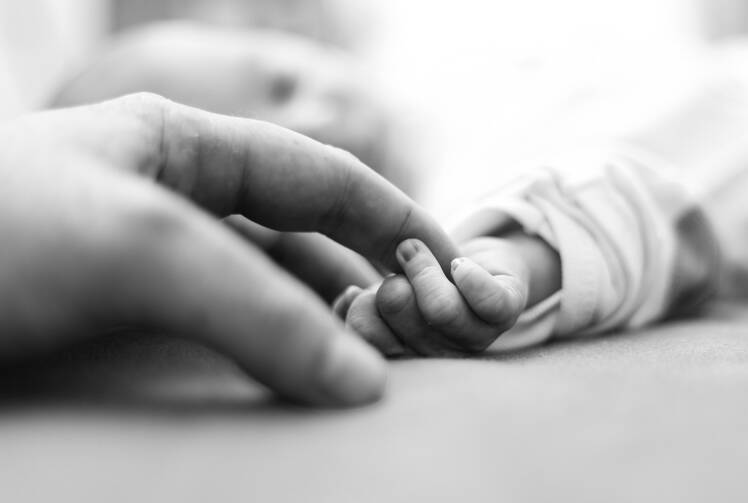My spouse and I welcomed a new addition to our family last spring. He doesn’t sleep through the night and now he is starting to teethe. But we are quick to look past all the fussiness because he is so cute.
Our son has been the source of much joy for our entire family ever since we learned my wife was pregnant. Before we knew his gender, some friends asked us if we wanted a boy or a girl. We did not have a preference and were just delighted to be having a baby.
Before he was born, one of our family members started speculating about the color of his eyes and hair. Wouldn’t it be great, she said, if he had red hair and blue eyes? I did not think much of it at the time. We have red hair on both my mother’s and father’s side of the family. His hair (whenever it comes in) might end up being red, or a bit reddish. Who knows?
But, over the months, this family member kept bringing it up, even after my son was born. My eldest son, who just started high school, took biology over summer. “Wouldn’t it be great if your little brother had blue eyes,” she said to him. “It’s unlikely,” my son said flatly, having recently learned about alleles. (Both my wife and I have brown eyes.)
Before he was born, one of our family members started speculating about the color of his eyes and hair. Wouldn’t it be great, she said, if he had red hair and blue eyes?
Unphased, this family member continued to express the preference. “Don’t you think it would be great if he had blue eyes?” she said as she held our son during a recent visit. “Well, they’re looking pretty dark to me,” I responded. “But whatever color his eyes are, I’m sure they’ll be beautiful.” There, I thought, that’ll put it to rest.
“They could be dark blue,” she retorted.
At first I was perplexed. Then I was annoyed. I thought it was a bit superficial, frankly. Afterall, whatever the color of his hair and eyes, we will love him just the same. It is not like we can control it. It only recently dawned on me what I was missing.
This family member is Latina. She is a Baby Boomer and came to the United States with her parents when she was a child. She has brown eyes and brown hair. Perhaps, when she moved to the United States, others judged her for the color of her hair and eyes—and skin.
Every year, from Sept. 15 to Oct. 15, the people of the United States acknowledge the influence of Latin America on our history.
I remembered that, despite being fluent in Spanish, this family member did not teach her own child to speak Spanish. Maybe what she is expressing with the hair and eye color preference is a desire that our son not face the same prejudice she did.
She seems to have a desire for my son to have an invisible Latinidad so that he is protected from judgment. Sentiments like hers are precisely why we still need to observe Hispanic Heritage Month.
Every year, from Sept. 15 to Oct. 15, the people of the United States acknowledge the influence of Latin America on our history. Those dates coincide with the independence days of many Latin American countries. Sept. 15, for example, is the independence day of Costa Rica, El Salvador, Guatemala, Honduras and Nicaragua. Mexico’s independence day is Sept. 16.
Personally, I have not always embraced Hispanic Heritage Month. I am from the Dominican Republic, but grew up in the Southwest. My white friends always seemed confused that, while I spoke Spanish, I was not Mexican. They also could not understand why my mom didn’t cook spicy food. Terms like “Hispanic” and “Latino” group together so many different cultures that our unique traditions can get lost.
It is important to recognize and celebrate that history, especially in the church, where the majority of Catholics under 30 have Latin American roots.
And there are a lot of traditions. Most countries in the Western Hemisphere are in Latin America, yet immigrants from these countries often get lumped together. A number of my Latino friends dislike the term “Hispanic” because it reminds them of Spanish imperialism. In addition to Spain, Latin Americans also trace their ancestry to the indigenous and to Africa. We’re grouped together in part because we ostensibly all speak Spanish, though not all of us do—not even in Latin America.
Still, however imperfect, Hispanic Heritage Month highlights how Latinos have been a part of the development of the United States for centuries in places like Florida, California, New Mexico and Colorado. It is important to recognize and celebrate that history, especially in the church, where the majority of Catholics under 30 have Latin American roots.
And it is important to celebrate Hispanic Heritage Month because some of us, like the family member I mentioned, seem to be ashamed of our Latinidad. Whatever the color of our eyes or hair or skin, these 30 days are a time to take pride in who we are, recognize the contributions we have made to this country and know we will always have a role to play in the history of the United States.








